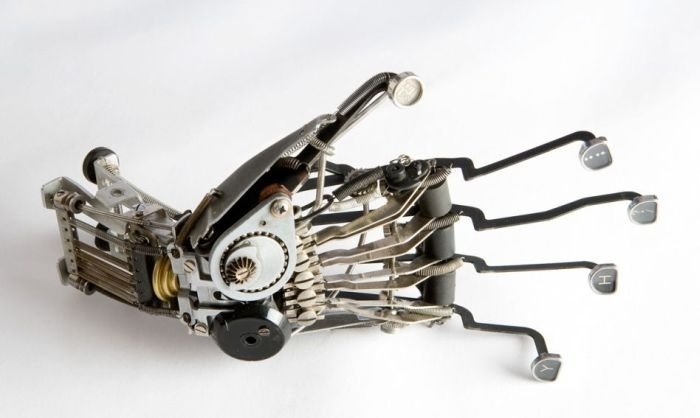|
|
Sculpture Made Out Of Typewriter Parts
|
The "QWERTY" layout typewriter keys became a de facto standard and continues to be used long after the reasons for its adoption (including reduction key/lever entanglements) have ceased to apply.
The 1874 Sholes & Glidden typewriters established the "QWERTY" layout for the letter keys. During the period in which Sholes and his colleagues were experimenting with this invention, other keyboard arrangements were apparently tried, but these are poorly documented. The near-alphabetical sequence on the "home row" the QWERTY layout (a-s-d-f-g-h-j-k-l) demonstrates that a straightforward alphabetical arrangement was the original starting point. The QWERTY layout keys has become the de facto standard for English-language typewriter and computer keyboards. Other languages written in the Latin alphabet sometimes use variants the QWERTY layouts, such as the French AZERTY, the Italian QZERTY and the German QWERTZ layouts.
The QWERTY layout is not the most efficient layout possible, since it requires a touch-typist to move his or her fingers between rows to type the most common letters. A popular story suggests that it was designed and used for early typewriters exactly because it was so inefficient; it slowed a typist down so as to reduce the frequency the typewriter's typebars wedging together and jamming the machine. Another story is that the QWERTY layout allowed early typewriter salesmen to impress their customers by being able to easily type out the example word "typewriter" without having learnt the full keyboard layout, because "typewriter" can be spelled purely on the top row the keyboard. The most likely explanation is that the QWERTY arrangement was designed to reduce the likelihood internal clashing by placing commonly used combinations letters farther from each other inside the machine. This allowed the user to type faster without jamming. Unfortunately, no definitive explanation for the QWERTY keyboard has been found, and typewriter aficionados continue to debate the issue.
A number radically different layouts such as Dvorak have been proposed to reduce the perceived inefficiencies QWERTY, but none have been able to displace the QWERTY layout; their proponents claim considerable advantages, but so far none has been widely used. The Blickensderfer typewriter with its DHIATENSOR layout may have possibly been the first attempt at optimizing the keyboard layout for efficiency advantages.
|
|









